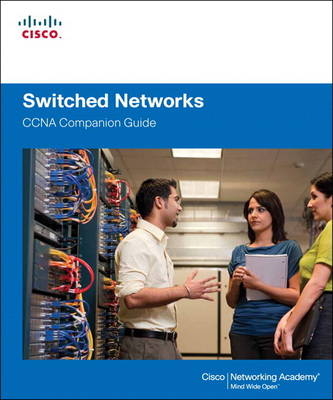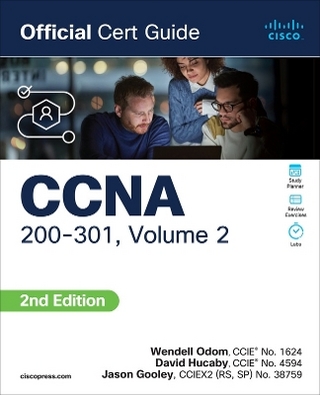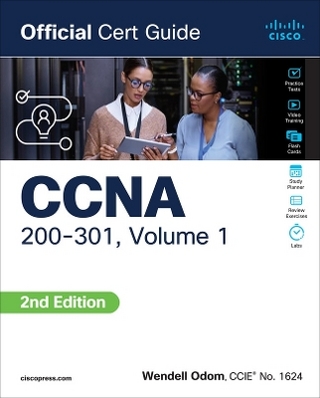
Switched Networks Companion Guide
Cisco Press (Verlag)
978-1-58713-329-9 (ISBN)
- Titel ist leider vergriffen;
keine Neuauflage - Artikel merken
This course describes the architecture, components, and operations of a converged switched network. You will learn about the hierarchical network design model and how to configure a switch for basic and advanced functionality. By the end of this course, you will be able to troubleshoot and resolve common issues with Virtual LANs and inter-VLAN routing in a converged network. You will also develop the knowledge and skills needed to implement a WLAN in a small-to-medium network.
The Companion Guide is designed as a portable desk reference to use anytime, anywhere to reinforce the material from the course and organize your time.
The book’s features help you focus on important concepts to succeed in this course:
Chapter objectives–Review core concepts by answering the focus questions listed at the beginning of each chapter.
Key terms–Refer to the lists of networking vocabulary introduced and highlighted in context in each chapter.
Glossary–Consult the comprehensive Glossary more than 300 terms.
Summary of Activities and Labs–Maximize your study time with this complete list of all associated practice exercises at the end of each chapter.
Check Your Understanding–Evaluate your readiness with the end-of-chapter questions that match the style of questions you see in the online course quizzes. The answer key explains each answer.
Related Title:
Switched Networks Lab Manual
ISBN-10: 1-58713-327-X
ISBN-13: 978-1-58713-327-5
How To–Look for this icon to study the steps you need to learn to perform certain tasks.
Interactive Activities–Reinforce your understanding of topics with all the different exercises from the online course identified throughout the book with this icon.
Videos–Watch the videos embedded within the online course.
Packet Tracer Activities–Explore and visualize networking concepts using Packet Tracer exercises interspersed throughout the chapters.
Hands-on Labs–Work through all the course labs and Class Activities that are included in the course and published in the separate Lab Manual.
Erich Spengler is the Director for the Center for System Security and Information Assurance, based at Moraine Valley CC. Erich is a Professor of Computer Integrated Technologies at Moraine Valley and has been teaching Cisco Academy courses for over 15 years. Erich is an ITQ-certified instructor for Cisco Academy. Erich is an active CISSP and has helped dozens of others earn the CISSP designation. Erich has over 25 years of professional experience in IT systems and security. Erich’s Center has trained over 1000 faculty since 2003 in VMware, CyberSecurity, Cisco, EMC, and Linux. In his downtime, Erich enjoys spending time with his wife and two daughters. Wayne Lewis wears three hats: Cisco Academy Manager for the Pacific Center for Advanced Technology Training, NetAcad Contact for the Central Pacific Academy Support and Instructor Training Center, and Professor at Honolulu Community College. Okay . . . four hats: Wayne teaches calculus, linear algebra, and differential equations at the University of Hawaii at Manoa. Honolulu CC has been an instructor training center for Cisco Academy since 1998, and its instructors are responsible for training many of the initial cohorts of Cisco Academy instructors in countries throughout Asia, Europe, and the Americas. Wayne has been involved in curriculum development and assessment for Cisco Academy since 1999. Wayne spends his free time doing math (representation theory, algebraic geometry, and several complex variables) and watching marathon sessions of TV series with his family (their favorites to rewatch are South Park, The Office, Monty Python, and Lost).
Introduction xix
Chapter 1 Introduction to Switched Networks 1
Objectives 1
Key Terms 1
Introduction (1.0.1.1) 2
LAN Design (1.1) 3
Converged Networks (1.1.1) 3
Growing Complexity of Networks (1.1.1.1) 3
Elements of a Converged Network (1.1.1.2) 5
Cisco Borderless Network (1.1.1.3) 6
Hierarchy in the Borderless Switched Network (1.1.1.4) 7
Access, Distribution, and Core Layers (1.1.1.5) 9
Switched Networks (1.1.2) 11
Role of Switched Networks (1.1.2.1) 12
Form Factors (1.1.2.2) 13
Traffic Flow (1.1.2.3) 15
Multilayer Switching (1.1.2.4) 16
Switch Features (1.1.3) 17
Port Density (1.1.3.1) 17
Forwarding Rates (1.1.3.2) 19
Power over Ethernet (1.1.3.3) 19
Cisco Catalyst Switch Breakdown (1.1.3.4) 21
The Switched Environment (1.2) 23
Frame Forwarding (1.2.1) 23
Switching as a General Concept in Networking and Telecommunications (1.2.1.1) 23
Dynamically Populating a Switch MAC Address Table (1.2.1.2) 25
Switch Forwarding Methods (1.2.1.3) 28
Store-and-Forward Switching (1.2.1.4) 29
Cut-Through Switching (1.2.1.5) 30
Switching Domains (1.2.2) 31
Collision Domains (1.2.2.1) 32
Broadcast Domains (1.2.2.2) 32
Alleviating Network Congestion (1.2.2.3) 33
Summary (1.3) 35
Practice 37
Class Activities 37
Labs 37
Packet Tracer Activities 37
Check Your Understanding Questions 37
Chapter 2 Basic Switching Concepts and Configuration 41
Objectives 41
Key Terms 41
Introduction (2.0.1.1) 42
Basic Switch Configuration (2.1) 43
Configure a Switch with Initial Settings (2.1.1) 43
Switch Boot Sequence (2.1.1.1) 43
Recovering From a System Crash (2.1.1.2) 44
Switch LED Indicators (2.1.1.3) 45
Preparing for Basic Switch Management (2.1.1.4) 47
Configuring Basic Switch Management Access with IPv4 (2.1.1.5) 47
Configure Switch Ports (2.1.2) 50
Duplex Communication (2.1.2.1) 50
Configure Switch Ports at the Physical Layer (2.1.2.2) 51
Auto-MDIX (2.1.2.3) 52
Verifying Switch Port Configuration (2.1.2.4) 53
Network Access Layer Issues (2.1.2.5) 55
Troubleshooting Network Access Layer Issues (2.1.2.6) 58
Switch Security: Management and Implementation (2.2) 59
Secure Remote Access (2.2.1) 60
SSH Operation (2.2.1.1) 60
Configuring SSH (2.2.1.2) 62
Verifying SSH (2.2.1.3) 64
Security Concerns in LANs (2.2.2) 66
Common Security Attacks: MAC Address Flooding (2.2.2.1) 66
Common Security Attacks: DHCP Spoofing (2.2.2.2) 69
Common Security Attacks: Leveraging CDP (2.2.2.3) 70
Security Best Practices (2.2.3) 72
Best Practices (2.2.3.1) 72
Network Security Tools and Testing (2.2.3.2) 73
Network Security Audits (2.2.3.3) 74
Switch Port Security (2.2.4) 74
Secure Unused Ports (2.2.4.1) 74
DHCP Snooping (2.2.4.2) 75
Port Security: Operation (2.2.4.3) 77
Port Security: Violation Modes (2.2.4.4) 78
Port Security: Configuring (2.2.4.5) 80
Port Security: Verifying (2.2.4.6) 81
Ports in Error-Disabled State (2.2.4.7) 83
Network Time Protocol (NTP) (2.2.4.8) 85
Summary (2.3) 88
Practice 90
Class Activities 90
Labs 90
Packet Tracer Activities 90
Check Your Understanding Questions 91
Chapter 3 VLANs 95
Objectives 95
Key Terms 95
Introduction (3.0.1.1) 96
VLAN Segmentation (3.1) 97
Overview of VLANs (3.1.1) 97
VLAN Definitions (3.1.1.1) 97
Benefits of VLANs (3.1.1.2) 98
Types of VLANs (3.1.1.3) 99
Voice VLANs (3.1.1.4) 101
VLANs in a Multiswitch Environment (3.1.2) 102
VLAN Trunks (3.1.2.1) 102
Controlling Broadcast Domains with VLANs (3.1.2.2) 103
Tagging Ethernet Frames for VLAN Identification (3.1.2.3) 105
Native VLANs and 802.1Q Tagging (3.1.2.4) 106
Voice VLAN Tagging (3.1.2.5) 107
VLAN Implementations (3.2) 109
VLAN Assignment (3.2.1) 109
VLAN Ranges on Catalyst Switches (3.2.1.1) 110
Creating a VLAN (3.2.1.2) 111
Assigning Ports to VLANs (3.2.1.3) 112
Changing VLAN Port Membership (3.2.1.4) 113
Deleting VLANs (3.2.1.5) 116
Verifying VLAN Information (3.2.1.6) 117
VLAN Trunks (3.2.2) 119
Configuring IEEE 802.1Q Trunk Links (3.2.2.1) 119
Resetting the Trunk to the Default State (3.2.2.2) 121
Verifying Trunk Configuration (3.2.2.3) 123
Dynamic Trunking Protocol (3.2.3) 124
Introduction to DTP (3.2.3.1) 125
Negotiated Interface Modes (3.2.3.2) 126
Troubleshoot VLANs and Trunks (3.2.4) 128
IP Addressing Issues with VLAN (3.2.4.1) 128
Missing VLANs (3.2.4.2) 129
Introduction to Troubleshooting Trunks (3.2.4.3) 131
Common Problems with Trunks (3.2.4.4) 132
Trunk Mode Mismatches (3.2.4.5) 133
Incorrect VLAN List (3.2.4.6) 135
VLAN Security and Design (3.3) 138
Attacks on VLANs (3.3.1) 138
Switch Spoofing Attack (3.3.1.1) 138
Double-Tagging Attack (3.3.1.2) 139
PVLAN Edge (3.3.1.3) 140
VLAN Best Practices (3.3.2) 142
VLAN Design Guidelines (3.3.2.1) 142
Summary (3.4) 144
Practice 146
Class Activities 146
Labs 146
Packet Tracer Activities 146
Check Your Understanding Questions 147
Chapter 4 LAN Redundancy 151
Objectives 151
Key Terms 151
Introduction (4.0.1.1) 153
Spanning Tree Concepts (4.1) 154
STP Operation (4.1.2) 154
Redundancy at OSI Layers 1 and 2 (4.1.1.1) 154
Issues with Layer 1 Redundancy: MAC Database Instability (4.1.1.2) 156
Issues with Layer 1 Redundancy: Broadcast Storms (4.1.1.3) 161
Issues with Layer 1 Redundancy: Duplicate Unicast Frames (4.1.1.4) 161
STP Operation (4.1.2) 162
Spanning Tree Algorithm: Introduction (4.1.2.1) 162
Spanning Tree Algorithm: Port Roles (4.1.2.2) 165
Spanning Tree Algorithm: Root Bridge (4.1.2.3) 167
Spanning Tree Algorithm: Path Cost (4.1.2.4) 168
802.1D BPDU Frame Format (4.1.2.5) 171
BPDU Propagation and Process (4.1.2.6) 173
Extended System ID (4.1.2.7) 178
Varieties of Spanning Tree Protocols (4.2) 182
Overview (4.2.1) 182
List of Spanning Tree Protocols (4.2.1.1) 182
Characteristics of the Spanning Tree Protocols (4.2.1.2) 183
PVST+ (4.2.2) 185
Overview of PVST+ (4.2.2.1) 185
Port States and PVST+ Operation (4.2.2.2) 186
Extended System ID and PVST+ Operation (4.2.2.3) 188
Rapid PVST+ (4.2.3) 189
Overview of Rapid PVST+ (4.2.3.1) 189
RSTP BPDU (4.2.3.2) 190
Edge Ports (4.2.3.3) 192
Link Types (4.2.3.4) 192
Spanning Tree Configuration (4.3) 193
PVST+ Configuration (4.3.1) 193
Catalyst 2960 Default Configuration (4.3.1.1) 194
Configuring and Verifying the Bridge ID (4.3.1.2) 194
PortFast and BPDU Guard (4.3.1.3) 196
PVST+ Load Balancing (4.3.1.4) 199
Rapid PVST+ Configuration (4.3.2) 202
Spanning Tree Mode (4.3.2.1) 202
STP Configuration Issues (4.3.3) 205
Analyzing the STP Topology (4.3.3.1) 205
Expected Topology Versus Actual Topology (4.3.3.2) 206
Overview of Spanning Tree Status (4.3.3.3) 207
Spanning Tree Failure Consequences (4.3.3.4) 207
Repairing a Spanning Tree Problem (4.3.3.5) 210
First Hop Redundancy Protocols (4.4) 210
Concept of First Hop Redundancy Protocols (4.4.1) 211
Default Gateway Limitations (4.4.1.1) 211
Router Redundancy (4.4.1.2) 212
Steps for Router Failover (4.4.1.3) 213
Varieties of First Hop Redundancy Protocols (4.4.2) 214
First Hop Redundancy Protocols (4.4.2.1) 214
FHRP Verification (4.4.3) 215
HSRP Verification (4.4.3.1) 216
GLBP Verification (4.4.3.2) 217
Summary (4.5) 220
Practice 221
Class Activities 221
Labs 221
Packet Tracer Activities 221
Check Your Understanding Questions 222
Chapter 5 Link Aggregation 227
Objectives 227
Key Terms 227
Introduction (5.0.1.1) 228
Link Aggregation Concepts (5.1) 228
Link Aggregation (5.1.1) 229
Introduction to Link Aggregation (5.1.1.1) 229
Advantages of EtherChannel (5.1.1.2) 230
EtherChannel Operation (5.1.2) 231
Implementation Restrictions (5.1.2.1) 231
Port Aggregation Protocol (5.1.2.2) 232
Link Aggregation Control Protocol (5.1.2.3) 234
Link Aggregation Configuration (5.2) 235
Configuring EtherChannel (5.2.1) 235
Configuration Guidelines (5.2.1.1) 236
Configuring Interfaces (5.2.1.2) 237
Verifying and Troubleshooting EtherChannel (5.2.2) 238
Verifying EtherChannel (5.2.2.1) 238
Troubleshooting EtherChannel (5.2.2.2) 241
Summary (5.3) 245
Practice 246
Class Activities 246
Labs 246
Packet Tracer Activities 246
Check Your Understanding Questions 247
Chapter 6 Inter-VLAN Routing 251
Objectives 251
Key Terms 251
Introduction (6.0.1.1) 252
Inter-VLAN Routing Configuration (6.1) 252
Inter-VLAN Routing Operation (6.1.1) 253
What Is Inter-VLAN Routing? (6.1.1.1) 253
Legacy Inter-VLAN Routing (6.1.1.2) 254
Router-on-a-Stick Inter-VLAN Routing (6.1.1.3) 255
Multilayer Switch Inter-VLAN Routing (6.1.1.4) 256
Configure Legacy Inter-VLAN Routing (6.1.2) 257
Configure Legacy Inter-VLAN Routing: Preparation (6.1.2.1) 257
Configure Legacy Inter-VLAN Routing: Switch Configuration (6.1.2.2) 259
Configure Legacy Inter-VLAN Routing: Router Interface Configuration (6.1.2.3) 260
Configure Router-on-a-Stick Inter-VLAN Routing (6.1.3) 262
Configure Router-on-a-Stick: Preparation (6.1.3.1) 262
Configure Router-on-a-Stick: Switch Configuration (6.1.3.2) 264
Configure Router-on-a-Stick: Router Subinterface Configuration (6.1.3.3) 265
Configure Router-on-a-Stick: Verifying Subinterfaces (6.1.3.4) 266
Configure Router-on-a-Stick: Verifying Routing (6.1.3.5) 268
Troubleshoot Inter-VLAN Routing (6.2) 270
Inter-VLAN Configuration Issues (6.2.1) 270
Switch Port Issues (6.2.1.1) 270
Verify Switch Configuration (6.2.1.2) 272
Interface Issues (6.2.1.3) 273
Verify Router Configuration (6.2.1.4) 274
IP Addressing Issues (6.2.2) 276
Errors with IP Addresses and Subnet Masks (6.2.2.1) 276
Verifying IP Address and Subnet Mask Configuration
Issues (6.2.2.2) 278
Layer 3 Switching (6.3) 280
Layer 3 Switching Operation and Configuration (6.3.1) 280
Introduction to Layer 3 Switching (6.3.1.1) 280
Inter-VLAN Routing with Switch Virtual Interfaces (6.3.1.2) 282
Inter-VLAN Routing with Routed Ports (6.3.1.4) 284
Configuring Static Routes on a Catalyst 2960 Switch (6.3.1.5) 285
Troubleshoot Layer 3 Switching (6.3.2) 291
Layer 3 Switch Configuration Issues (6.3.2.1) 291
Example: Troubleshooting Layer 3 Switching (6.3.2.2) 292
Summary (6.4) 295
Practice 296
Class Activities 296
Labs 296
Packet Tracer Activities 296
Check Your Understanding Questions 297
Chapter 7 DHCP 303
Objectives 303
Key Terms 303
Introduction (7.0.1.1) 305
Dynamic Host Configuration Protocol v4 (7.1) 306
DHCPv4 Operation (7.1.1) 306
Introducing DHCPv4 (7.1.1.1) 306
DHCPv4 Operation (7.1.1.2) 307
DHCPv4 Message Format (7.1.1.3) 311
DHCPv4 Discover and Offer Messages (7.1.1.4) 313
Configuring a Basic DHCPv4 Server (7.1.2) 315
Configuring a Basic DHCPv4 Server (7.1.2.1) 315
Verifying DHCPv4 (7.1.2.2) 318
DHCPv4 Relay (7.1.2.3) 322
Configure DHCPv4 Client (7.1.3) 325
Configuring a Router as DHCPv4 Client (7.1.3.1) 325
Configuring a SOHO Router as a DHCPv4 Client (7.1.3.2) 326
Troubleshoot DHCPv4 (7.1.4) 327
Troubleshooting Tasks (7.1.4.1) 327
Verify Router DHCPv4 Configuration (7.1.4.2) 329
Debugging DHCPv4 (7.1.4.3) 330
Dynamic Host Configuration Protocol for IPv6 (DHCPv6) (7.2) 331
SLAAC and DHCPv6 (7.2.1) 331
Stateless Address Autoconfiguration (SLAAC) (7.2.1.1) 331
SLAAC Operation (7.2.1.2) 333
SLAAC and DHCPv6 (7.2.1.3) 335
SLAAC Option (7.2.1.4) 336
Stateless DHCPv6 Option (7.2.1.5) 337
Stateful DHCPv6 Option (7.2.1.6) 338
DHCPv6 Operations (7.2.1.7) 339
Stateless DHCPv6 (7.2.2) 342
Configuring a Router as a Stateless DHCPv6 Server (7.2.2.1) 342
Configuring a Router as a Stateless DHCPv6 Client (7.2.2.2) 344
Verifying Stateless DHCPv6 (7.2.2.3) 344
Stateful DHCPv6 Server (7.2.3) 346
Configuring a Router as a Stateful DHCPv6 Server (7.2.3.1) 346
Configuring a Router as a Stateful DHCPv6 Client (7.2.3.2) 349
Verifying Stateful DHCPv6 (7.2.3.3) 349
Configuring a Router as a DHCPv6 Relay Agent (7.2.3.4) 351
Troubleshoot DHCPv6 (7.2.4) 352
Troubleshooting Tasks (7.2.4.1) 353
Verify Router DHCPv6 Configuration (7.2.4.2) 354
Debugging DHCPv6 (7.2.4.3) 355
Summary (7.3) 357
Practice 359
Class Activities 359
Labs 359
Packet Tracer Activities 359
Check Your Understanding Questions 360
Chapter 8 Wireless LANs 363
Objectives 363
Key Terms 363
Introduction (8.0.1.1) 367
Wireless Concepts (8.1) 367
Introduction to Wireless (8.1.1) 367
Supporting Mobility (8.1.1.1) 368
Benefits of Wireless (8.1.1.2) 368
Wireless Technologies (8.1.1.3) 369
Radio Frequencies (8.1.1.4) 370
802.11 Standards (8.1.1.5) 371
Wi-Fi Certification (8.1.1.6) 373
Comparing WLANs to a LAN (8.1.1.7) 375
Components of WLANs (8.1.2) 376
Wireless NICs (8.1.2.1) 376
Wireless Home Router (8.1.2.2) 377
Business Wireless Solutions (8.1.2.3) 379
Wireless Access Points (8.1.2.4) 380
Small Wireless Deployment Solutions (8.1.2.5) 382
Large Wireless Deployment Solutions (8.1.2.6) 385
Large Wireless Deployment Solutions, Cont. (8.1.2.7) 387
Wireless Antennas (8.1.2.8) 389
802.11 WLAN Topologies (8.1.3) 391
802.11 Wireless Topology Modes (8.1.3.1) 391
Ad Hoc Mode (8.1.3.2) 392
Infrastructure Mode (8.1.3.3) 393
Wireless LAN Operations (8.2) 395
802.11 Frame Structure (8.2.1) 395
Wireless 802.11 Frame (8.2.1.1) 395
Frame Control Field (8.2.1.2) 397
Wireless Frame Type (8.2.1.3) 399
Management Frames (8.2.1.4) 400
Control Frames (8.2.1.5) 402
Wireless Operation (8.2.2) 403
Carrier Sense Multiple Access with Collision Avoidance (8.2.2.1) 404
Wireless Clients and Access Point Association (8.2.2.2) 405
Association Parameters (8.2.2.3) 406
Discovering APs (8.2.2.4) 409
Authentication (8.2.2.5) 411
Channel Management (8.2.3) 413
Frequency Channel Saturation (8.2.3.1) 413
Selecting Channels (8.2.3.2) 415
Planning a WLAN Deployment (8.2.3.3) 418
Wireless LAN Security (8.3) 420
WLAN Threats (8.3.1) 420
Securing Wireless (8.3.1.1) 420
DoS Attack (8.3.1.2) 422
Management Frame DoS Attacks (8.3.1.3) 423
Rogue Access Points (8.3.1.4) 425
Man-in-the-Middle Attack (8.3.1.5) 426
Securing WLANs (8.3.2) 428
Wireless Security Overview (8.3.2.1) 428
Shared Key Authentication Methods (8.3.2.2) 430
Encryption Methods (8.3.2.3) 432
Authenticating a Home User (8.3.2.4) 432
Authentication in the Enterprise (8.3.2.5) 434
Wireless LAN Configuration (8.4) 435
Configure a Wireless Router (8.4.1) 435
Configuring a Wireless Router (8.4.1.1) 435
Setting Up and Installing Initial Linksys EA6500 (8.4.1.2) 437
Configuring the Linksys Smart Wi-Fi Home Page (8.4.1.3) 441
Smart Wi-Fi Settings (8.4.1.4) 443
Smart Wi-Fi Tools (8.4.1.5) 446
Backing Up a Configuration (8.4.1.6) 450
Configuring Wireless Clients (8.4.2) 452
Connecting Wireless Clients (8.4.2.1) 452
Troubleshoot WLAN Issues (8.4.3) 453
Troubleshooting Approaches (8.4.3.1) 453
Wireless Client Not Connecting (8.4.3.2) 455
Troubleshooting When the Network Is Slow (8.4.3.3) 456
Updating Firmware (8.4.3.4) 458
Summary (8.5) 460
Practice 461
Class Activities 461
Labs 462
Packet Tracer Activities 462
Check Your Understanding Questions 462
Appendix A Answers to “Check Your Understanding” Questions 465
Glossary 477
9781587133299, TOC, 4/14/14
| Erscheint lt. Verlag | 29.5.2014 |
|---|---|
| Verlagsort | Indianapolis |
| Sprache | englisch |
| Maße | 211 x 233 mm |
| Gewicht | 1156 g |
| Themenwelt | Mathematik / Informatik ► Informatik ► Netzwerke |
| Informatik ► Weitere Themen ► Zertifizierung | |
| ISBN-10 | 1-58713-329-6 / 1587133296 |
| ISBN-13 | 978-1-58713-329-9 / 9781587133299 |
| Zustand | Neuware |
| Haben Sie eine Frage zum Produkt? |
aus dem Bereich


